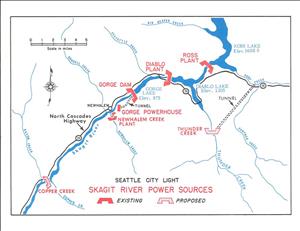On August 18, 1949, the third stage of Ross Dam, located in southeast Whatcom County on the Skagit River, is complete. Owned by Seattle City Light, the dam will provide hydroelectric power to the City of Seattle. The dam is 540 feet high and creates Ross Lake which, when full, rises 1,600 feet above sea level. Ross Lake extends into British Columbia, which is 20 miles from the dam.
By 1956, four generators at Ross Dam had produced a total of 360,000 kilowatts of electricity for Seattle.
After 1954, Ross Lake began to flood Canadian territory. City Light agreed to pay $250,000 for the loss of 5,475 acres of land, plus another $5,000 a year. The dam was constructed with the potential of it rising another 125 feet. When this option was planned in the 1960s, Canada objected. City Light eventually agreed to abandon this plan in exchange for the right to buy electricity from British Columbia.
Sources:
Paul C. Pitzer, Building the Skagit: A Century of Upper Skagit Valley History, 1870-1970 (Portland: The Galley Press, 1988), 87-89.
Licensing: This essay is licensed under a Creative Commons license that
encourages reproduction with attribution. Credit should be given to both
HistoryLink.org and to the author, and sources must be included with any
reproduction. Click the icon for more info. Please note that this
Creative Commons license applies to text only, and not to images. For
more information regarding individual photos or images, please contact
the source noted in the image credit.

Major Support for HistoryLink.org Provided
By:
The State of Washington | Patsy Bullitt Collins
| Paul G. Allen Family Foundation | Museum Of History & Industry
| 4Culture (King County Lodging Tax Revenue) | City of Seattle
| City of Bellevue | City of Tacoma | King County | The Peach
Foundation | Microsoft Corporation, Other Public and Private
Sponsors and Visitors Like You

